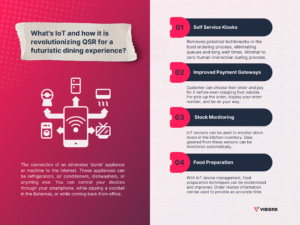With the technological footprint increasing day by day in our lives, you will be hard pressed to find a field untouched by it. It makes sense too. The use of technological innovations has, for the most part, made our lives exponentially better. One such avenue of this improvement is through IoT sensors and IoT device management.
From the HVAC industry to residential equipment, the “Internet of Things”, or IoT for short, has made its mark. It has transformed the way we go about our lives. It has also ensured the smooth continuation of our daily routine along with technology, rather than against it. Moreover, for corporations, it has resulted in increased revenue streams.

According to a Kaspersky study, 61% of businesses use IoT to improve their business operations. This number is only predicted to increase. This serves as a testament to the viability and effectiveness of IoT implementation.
One such application of IoT device management in a business setting is within the restaurant industry, or more specifically, Quick Service Restaurants (QSR).Before we move further into the depths of QSR, let’s first refresh our knowledge on IoT and its workings.
What Is IoT?
To know more about the implementation of IoT in QSR, it is important to know about IoT itself.
The Internet of Things is a broad concept. At its core though, it means the connection of an otherwise ‘dumb’ appliance or machine to the internet. These appliances can be refrigerators, air conditioners, dishwashers, or anything else.This connectivity affords the otherwise standalone appliance much greater versatility. You can control your devices through your smartphone, while sipping a cocktail in the Bahamas, or while coming back from office.
Within an IoT system, there are a few components at work. For starters, there is the appliance or device itself. It is connected to the internet and supported by a set of protocols and instructions. These protocols define the appliance’s interactions with other appliances and components of the system. These appliances are also referred to as IoT sensors. The reason is that they can be used as a source of real time feedback within the ecosystem and be used as the eyes and ears of it.
Furthermore, there is a central nervous system, commonly referred to as “the cloud”. You might have heard of AWS (Amazon Web Services) or Microsoft Azure. These are examples of a “cloud”. Essentially, these are off-site services through which a user can communicate with their appliance. Think of it as an intermediary of sorts.
Moreover, there can be sub-components within the cloud. These can include databases, analytical software, control software, and more. All these sub-systems work in harmony with each other to provide effective IoT device management.
And finally comes the user interface, in the form of a mobile application or web app. This is where the user can send out commands and instructions to the appliance. Even though this is a common example, but user interaction does not have to be limited to sending out commands only.
There can be instances where the user interaction is in the form of detailed statistical reports, or usage histories of the appliance. They can also be historical data about certain processes and events. In a nutshell, the flexibility offered by IoT enables you to have complete control over the outlook of your IoT ecosystem, where you can modify it according to your needs.
What Are The Security Concerns With IoT?
Although the large-scale adoption of IoT is encouraging, there are some concerns which do need to be addressed. The prime of them being security. Even though IoT sounds simple in its concept, actual implementation does have it challenges.
Multiple nodes in the system give various ways for mischief makers to wreak havoc. Data breaches need to be particularly guarded against. The blowback of such a breach happening within a residential system is significant, but for a corporation, it can be a death knell.
Which is why organizations are going to great lengths to make sure their IoT device management systems are locked up and safe. Infrastructure security is of paramount importance, and rightly so.
With a little overview on IoT complete, lets see how it is affecting the world of QSR and how it can create new opportunities for businesses.
Understanding QSR
The customers of today are completely different than before. They are mobile, always connected, short of time, and searching for convenience wherever possible.
Within the food industry, this means that for the most part, customers are wanting their interaction within the restaurant to be minimal, swift, and hassle free. The term fast food caters to this segment of the population, which does not place a high priority on the restaurant experience itself, but more so on practicality.
With the evolving customer demands, the impetus is on the QSR industry to transform itself and meet the challenges of today.
This might mean that the customer wants to pre-order their meal, and simply come for a pick-up. Another aspect might be advance payments for orders. Although these processes could be done through a telephone call in the old days, smartphone applications are the preferred method in today’s world.
How IoT For QSR Is Creating Restaurants Of The Future?
Incremental improvements are what every organization strives for, and QSR brands are no different. With the help of IoT, these restaurants are utilizing new and creative methods to make an impact to the customer.
This is not where it ends though. IoT is also being leveraged to bring process efficiencies in the kitchen for QSR brands as well. Let’s see how.
1. Self Service Kiosks
You might have witnessed these at a popular fast-food chain near you, and they are here to stay. Big screens greet you as you enter the doors and have an enticing tag line and menu items already on display. You simply walk up, enter your order details, and carry out the payments through an integrated payment system, which can either take a credit card or cash.
You will be assigned an order number, which is displayed at the pick-up point. As soon as you get called up, go to the counter, pick up your order, and you are done. As simple as that. Minimal to zero human interaction during the whole process.
This can not only save costs for the QSR brand, but also provide a much more personalized and non-intrusive experience to the customer. Moreover, it removes potential bottlenecks in the food ordering process, eliminating queues and long wait times.
2. Improved Payment Gateways
Self service kiosks take your order when you get to the restaurant, but what if you have your order in place before even getting there?
Many QSR brands are shifting their focus towards mobile applications, where the customer can choose their order and pay for it before even stepping foot outside. The order details are then passed over to the kitchen, where preparation can begin.
The customer can also set up an expected pick-up time, so that the restaurant knows when it has to be ready. To pick-up the order, you would have to simply display your order number, and be on your way.
3. Stock Monitoring
This aspect of IoT is more concerned with the workings of the kitchen itself. IoT sensors can be used to monitor stock levels in the kitchen inventory. These can be items in a refrigerator or freezer, or other food items on pallets or bags. The sensors can be in the form of various devices such as cameras and weight sensors.
Data gleaned from these sensors can be deposited into a central database and monitored automatically, raising an alarm when the stock is running low and needs to be replenished. With machine learning and predictive models, this technology can be used even more efficiently, by predicting expected stock levels in anticipation of a higher sale period, such as during a holiday.
Moreover, temperature sensors using Bluetooth Low Energy (BLE) can record data regarding cold-chain integrity. This ensures that spoiled food does not find its way to a customer order.
4. Food Preparation
With IoT device management, food preparation techniques can be modernized and improved. As an example, ovens and fryers can be paired up with IoT sensors in the shape of temperature sensors to alert an operator when the food items are cooked and ready.
In the case of an order pick-up, this information can be used to provide an accurate expected time to the customer for when their order would be ready. This not only saves the customer time, but also reduces traffic within the restaurant.
Closing it Down
The applications of IoT mentioned above are by no means exhaustive. The benefits of such technologies within the QSR industry are numerous, with each providing a unique advantage to the QSR brand. With the increasing adoption of such eccentric business use cases in the market, both at consumer and organizational levels, we at VisionX focus on providing QSR-enabled IoT technology to Fortune 500 companies which bounds to create marked differences in business growth.
